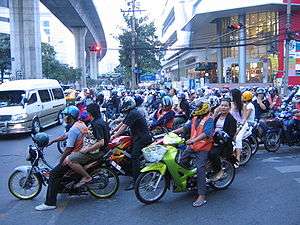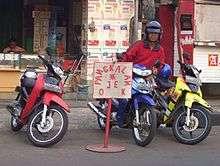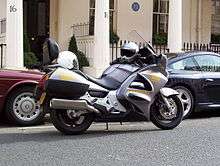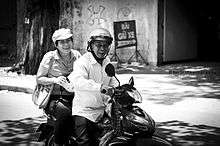Motorcycle taxi

A motorcycle taxi, or cart bike, is a licensed form of transport in some countries. The taxi typically carries one passenger, who rides as the pillion behind the motorcycle operator. Multiple passengers are common in some countries.
Brazil
According to some sources, motorcycle taxi service in Brazil began in 1994, in Crateús, in the state of Ceará,[1] when an employee of the Bank of Brazil bought 10 bikes for rent, for the transport of persons. Other sources state that it started in Bauru, São Paulo, in 1996, when an unemployed biker hung a banner across the road to the city, reading "help a biker racing to 1.00 real." Today, almost all Brazilian cities have motorcycle taxi service.[2] Recently, they have appeared in poorer and less urban areas, where young people increasingly support themselves by driving them.
Typically, the fare is a flat fee, regardless of the distance traveled. However, the charge may vary according to the time of day or day of the week, or increase for distances that are greater than usual.
Licensing requirements for motorcycle taxis vary by municipality. Small towns tend not to regulate them at all, while in larger cities, they are regulated in much the same way as taxicabs. In July 2009, the Brazilian Senate approved standards[3] for motorcycle taxi drivers and motorcycle couriers.[4] They must be at least 21 years old, have held a Category A drivers licence for at least two years, and have attended a training course.
Cambodia
In Phnom Penh and other cities in Cambodia, motorcycle taxis are widely available as a form of low-cost public transport. Motorcycle taxi drivers, who are almost exclusively male, are called motodops. They tend to hang around outside major tourist attractions, office buildings, public markets, and near the corners of residential streets. There is no regulated system of training or bike maintenance and no common uniform, so anyone on his way home from the market might offer you a ride (and the driver's intentions can generally be trusted, the state of his bike, a little less so). Always negotiate the fare in advance (use gestures, if necessary). Don't expect a motodop to understand English or to read a map - he'll likely flag somebody down who can help translate or navigate, if necessary. Fares vary depending on distance and weather but should always be cheaper than a tuk-tuk. Fares are higher at night and when embarking from tourist areas. You'll get a better rate if you can negotiate in passable Khmer, but have a heart: these are generally the folks that live on a few dollars or less per day. As of 2014, helmet laws apply only to drivers, so bring your own helmet if you're worried about safety, but it's not legally required.
Cameroon
Motorcycle taxis are also the most common form of transportation in Maroua, Cameroon.[5] Multiple passengers are carried on most trips; as many as four children are sometimes carried on a single motorcycle. Helmets are rarely used, but the traffic and speed are moderate in the city. Short distances cost about 200 francs, less than US$1.
China
In mainland China, motorcycle taxi service can be traced back to the late 1980s and early 1990s. There are currently motorcycle taxis throughout China, including in Beijing, Shanghai, and Guangzhou. They are popular primarily due to their low cost: the fare for short trips is just 5 yuan (less than US$1) per person.
India

On October 1, 2015, Rapido started its operations in Bangalore, India. Rapido is a platform where one can book a bike ride through a mobile app for traveling solo. Currently, the service is operational in Bangalore and Gurgaon. With the steadily rising urban population and four-wheelers overcrowding roads, Rapido is attempting to reduce the carbon footprint at a massive scale. Within a short period of time, Rapido has over 80,000 app downloads and delivered more than 2,50,000 rides. Rapido receives its funding from high profile investors. Pawan Munjal, CEO of Hero MotoCorp; Rajan Ananda, Vice President of Google, South East Asia & India; Anupam Mittal, CEO Shaadi.com & people group; Ankit Nagori, Ex-CBO Flipkart; Astarc ventures and Advantage.vc.
In May 6,2016 BOGO Bike Taxi introduced the first on-demand bike taxi service in Kolkata, West Bengal. Bogo Bike Taxi is founded by Moyukh Dutta and Souvik Bose. They have already completed 2000 rides in first month of operation.
In Goa, India, motorcycle taxis are required to be licensed. Driven by men called pilots, they are much cheaper than other taxis, although a passenger can only carry a backpack as luggage. In some parts of the state, motorcycle drivers are legally required to wear helmets, but any passengers riding pillion are not. Motorcycle taxis can usually be identified by their distinctive yellow and black colours. There is a practice to fix the fare in advance, and trips are not metered. A concept of motorcycle ride-share has been introduced by "Bikees" a company based in Chennai and "HeyTaxi" introduced in June 2015 by a company based in Mumbai. The authorities however closed down the project citing lack of licensing. HeyTaxi is currently operational as a bike rideshare provider and last mile delivery company in Mumbai and Bengaluru.
On December 1, 2015, Baxi,[6] started its commercial operations in Gurgaon, Haryana. The company wanted to get official permission from the Haryana government[7] and operate with legal yellow plates to function as commercial vehicles rather than operate as other companies before it with white plates. Baxi[8] received the highest amount of funding for a startup company of its size in November 2015 from HT Media and 25 other private investors and started off with a fleet of 26 motorcycles.
On March 7, 2016, HeyDidi a female bike taxi service was launched by HeyTaxi in Mumbai as their women's empowerment initiative, becoming the first all female bike taxi and instant delivery service. [9][10]
Indonesia

Motorcycle taxis are a very common form of unlicensed transport in Indonesia, where they are known as ojek. Ojek can be found in most areas of the country, from towns where traffic jams commonly hinder other forms of transport, to rural areas inaccessible by four-wheeled vehicles. Because of traffic, ojek are often the fastest form of transport, especially in Jakarta. Many people choose them over taxicabs, which are safer, but slower and more expensive.
Many ojek drivers either own their vehicles or are buying them on credit, although in some areas, stolen motorcycles are common. The widespread availability of cheap, domestic motorcycles made by Honda, Yamaha, and Suzuki, and even cheaper ones imported from China, as well as credit schemes with which to purchase these, have resulted in the rapid growth of ojek. The ease with which driver's licences can be obtained has also been a contributing factor.
Before the trip begins, the passenger usually haggles with the driver over the fare, which generally ranges from 5,000 to 10,000 rupiah (about US$0.50 to US$1.00) for short trips. Indonesian law requires motorcycle riders to wear helmets; often on ojek, however, only the driver does so. Although the driver will sometimes provide a helmet for the passenger, more often, drivers simply avoid main streets, and the attention of police.
GO-JEK, a mobile apps company whose ojek as the main service, has the name derived from the word itself.[11]
Nigeria
Nigeria has about three million motorcycle taxis,[12] locally called okadas, with over one million in Lagos alone. In Lagos, new rules prohibit okadas from carrying pregnant women or children. Authorities say okadas will be stopped from driving up the wrong way, and the number of roads on which they are authorized to travel will be sharply reduced.[13]
Philippines
Motorcycle taxis in the Philippines usually have sidecars, or seats extended sideways, often by use of a T-shaped crossbeam. The latter type of taxi is known as habal-habal, or a skylab,[14] owing to its crude resemblance to the Skylab space station which orbited the Earth in the 1970s.[15][16] Covered, three-wheel autorickshaws, known as tricycles, are also a common mode of transport.[17][18]
Sweden
In 1994 and 1995, there were several motorcycle taxis in Stockholm. Due to the city's northern latitude, motorcycle taxi service is only feasible during the warmer months, and it remains a niche industry. As of 2011, there is one company offering tours using two Chang Jiang sidecar motorcycles.
Thailand
Motorcycle taxis (Thai: มอเตอร์ไซค์รับจ้าง, motoesai rap chang,วินมอไซต์ (Vin Mosai ) , pronounced [mɔ̄ːtɤ̄ːsāj ráp t͡ɕâːŋ]) are a common form of public transport in Bangkok and most other cities, towns, and villages in Thailand. They are generally used for short trips. In Bangkok, there are motorcycle taxi queues on many sois, or side streets, and the queues are regulated by the city's government. Licensed motorcycle taxi operators wear vests. In compliance with Thailand's helmet law, many (but not all) drivers carry a spare helmet to offer to passengers. Bangkok locals generally only use motorcycle taxis when they need to get somewhere fast, as metered taxi-cabs are actually cheaper (but slower) than flat-rate motorcycles. Therefore, motorcycle taxi-drivers in Bangkok have built their reputation on delivering service as quickly as possible and tend to drive very fast and weave through traffic.
United Kingdom

Motorcycle taxi service in London began in 1990. It has established itself as a niche industry, never growing past a total of 15 bikes. All equipment is provided for the passenger, along with an intercom system linking the rider and passenger. The motorcycles have racks that can hold a carry-on suitcase, for trips to local airports, especially Stansted, Gatwick, and City. The bikes are now licensed by Transport for London and the Public Carriage Office, which also license London's black cabs. There are currently three firms based in London offering taxi bike service.
United States
A motorcycle for-hire service started in California and New York City in 2011. As with a sedan service, passengers may not hail the motorcycles on the street; instead, a yearly individual or corporate membership fee is charged, plus an hourly rate. Experienced riders, many former motorcycle police officers, carry clients on Honda Gold Wings, and in California, can bypass traffic congestion by lane splitting.[19] Passengers are provided with helmets, airbag vests, and in-helmet, Bluetooth cell phones. Besides the Gold Wings, the service bought several Can-Am Spyders, before realizing they were not capable of splitting lanes.[20]
Vietnam

Nimble motorcycle taxis, which surpass buses in speed and mobility, comprise one of the most popular modes of transportation in Vietnam, where they are known as xe ôm. Passengers can get a ride simply by hailing passing operators, or by finding drivers who gather at public places such as schools, markets, hospitals, and bus and train stations.[21]
See also
- Boda-boda, an East African term for a bicycle taxi or motorcycle taxi
Notes
- ↑ COELHO, Modesto Siebra. A nova onda no transporte urbano: mototáxi. Sobral-CE, Edições UVA, 1997
- ↑ ETUFOR, 27/04/2010, acesso em 19 de julho de 2011.
- ↑ O Globo, 10/07/2009, acesso em 12 de julho de 2009.
- ↑ Biker doing day or night rounds in gated communities , open residential neighborhoods or commercial areas
- ↑ Cameroon - Page 225 Ben West - 2011 Bradt Travel Guide Cameroon, 3rd edition
- ↑ "A ride-hailing app for scooters launches in Gurgaon". Retrieved 2016-02-07.
- ↑ "Bike taxis in Gurgaon get government nod". http://www.hindustantimes.com/. Retrieved 2016-02-07. External link in
|website=(help) - ↑ "Bike Taxi, Baxi Raises $1.5 Million In Seed Funding". NextBigWhat. Retrieved 2016-02-07.
- ↑ http://timesofindia.indiatimes.com/city/mumbai/Hey-Didi-starts-parcel-deliveries-plans-to-ride-women-home-safely/articleshow/51281806.cms
- ↑ http://heytaxi.in/womenempowerment.html
- ↑ Lee, Yoolim (4 August 2016). "Go-Jek Raises Over $550 Million in KKR, Warburg-Led Round". Bloomberg. Retrieved 25 August 2016.
- ↑ "Moto-Meter Granted a Patent in Nigeria -- Monopoly Guaranteed Until 2033". The Wall Street Journal.
- ↑ http://www.wheels24.co.za/News/General_News/Nigeria-limits-Lagos-taxi-drivers-20100831
- ↑ "House bill seeks to legalize 'habal-habal'". GMA News Online. 5 December 2013. Retrieved 9 August 2014.
- ↑ Mascarinas, Erwin (10 June 2013). "A ride on Mindanao's Skylab". InterAksyon. Retrieved 16 December 2015.
- ↑ "Habal-Habal: The Philippine Motorcycle That Gives 10 People a Ride". Global Voices. 6 April 2014. Retrieved 9 August 2014.
- ↑ Philippines - Page 450 Greg Bloom - 2009 "Tricycles, Kalesa & Habal-Habal Found in most cities and towns, the tricycle is the Philippine rickshaw – a little, roofed ... Habal-habal are essentially motorcycle taxis with extended seats (literally translated as 'pigs copulating,' "
- ↑ Greg Bloom Philippines 10th Ed 2010- Page 450 "Tricycles, Kalesa & Habal-Habal Found in most cities and towns, the tricycle is the Philippine rickshaw – a little, roofed sidecar bolted to a motorcycle. Tricycles are often garishly done up in the mode of a jeepney, and you'll likely hear one before you see one from the noise of the smoke-belching two-stroke engine. The standard fare for local trips in most provincial towns is P6. ...non-motorised push tricycles... put-put or podyak for shorter trips... Kalesa are two wheeled horse carriages"
- ↑ Carpenter, Susan (27 April 2011), "Moto Limos Club takes you there — by motorcycle", Los Angeles Times, retrieved 2011-04-29
- ↑ Siler, Wes (14 April 2011), "Motorcycle taxis come to America", Hell for Leather, retrieved 2011-04-29
- ↑ "Transportation in Hanoi". Retrieved 22 August 2012.
External links
![]() Media related to Taxi motorcycles at Wikimedia Commons
Media related to Taxi motorcycles at Wikimedia Commons